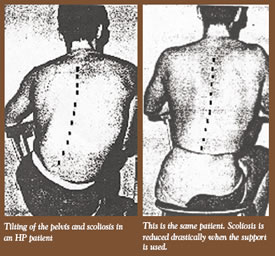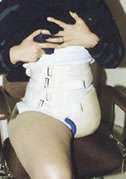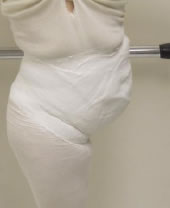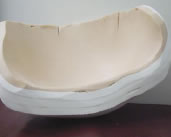Volume 15 · Issue 1 · January/February 2005 | Download PDF
by Christina Skoski, MD

While a soft pillow may suffice for hip-disarticulation amputees, firmer support is usually required for those with only soft tissue on one side. A classic “sitting socket” is nothing more than a device that wraps around the lower torso and provides a firm, level sitting surface – a socket without the leg attached. Although these sitting sockets have been recommended for people who use crutches and wheelchairs exclusively rather than a prosthesis, the older designs can be quite cumbersome, and many people rejected wearing them.

Simply put, the pelvic leveler is a lightweight, portable, firm, and comfortable support device that should be very easy for any prosthetist to fabricate.
Basic Instructions for Fabricating a Pelvic Leveler
1. Make a cast of the body like you are casting a socket for a prosthesis, concentrating only on the lower portion of the amputated side. This cast does not have to be precise and can be done over bandages on a new amputee or carved freehand if necessary. This provides a negative mold from which a positive mold can be created from plaster.

3. Gradually sand away the excess Pelite until the patient can comfortably sit up straight using it. The overall size and shape depends on the size of the patient and what he or she requires to sit comfortably.
4. The outside can be covered with a layer of leather for durability.

6. Another option is to hold it in place with a piece of neoprene or elastic over and around the hips and attached with Velcro. (Trans-USA Hip Disarticulation/Transpelvic Prostheses Tour: Part Two – Rochester, MN, John Michael’s Corner, October 2003 (http://www.oandp.com/news/jmcorner/2003-10/2.asp?searchquery=transpelvic)

About the Author
Christina Skoski, MD, has been a hemipelvectomy amputee since losing her leg to cancer as a teenager. Today, she is a clinical anesthesiologist and serves as a member of the Amputee Coalition’s Medical Advisory Committee. She created the first Web site specifically for pelvic amputation levels (http://www.hphdhelp.org).

